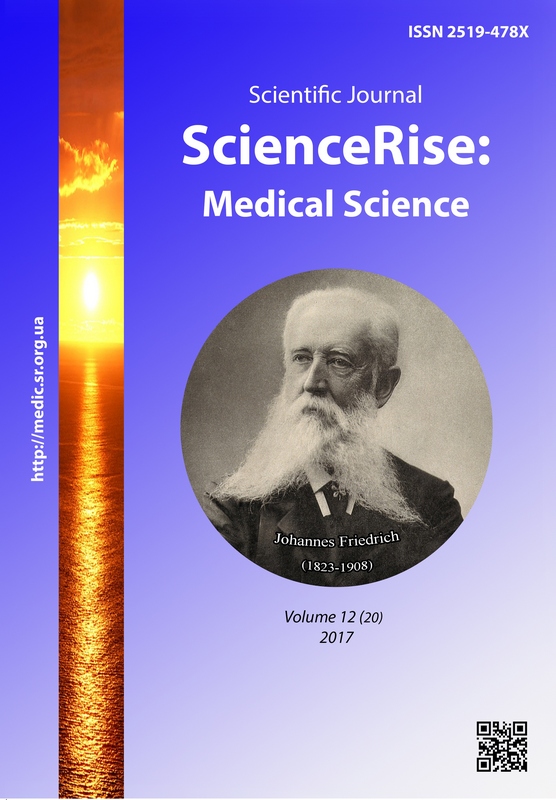Elimination of the transmission mother-to-child HIV and syphilis: the progress and challenges to Ukraine
DOI:
https://doi.org/10.15587/2519-4798.2017.119389Keywords:
pregnancy, НIV, syphilis, mother-to-child-transmission, congenital syphilis, elimination, validationAbstract
The objective of this study is to analyze the indicators of impact and process of EMTCT of HIV and syphilis in Ukraine thus helping to prepare for validation of this process according to the WHO targets and сriteria.
Materials and Methods. In this retrospective study were presented the epidemiological and clinical data about 237 women who had syphilis before or during pregnancy and babies born to them (238) from 1999 to 2007 yy. Besides in article were used statistical forms of the Public Health Center and Center for Medical Statistics of the Ministry of Health of Ukraine for the incidence of syphilis and HIV in women of reproductive age, pregnant women and children born to them, including those who were diagnosed with congenital syphilis and HIV infection from 2007 to 2016 yy
Results. The analysis of the data from Public Health Center shows that one of the target indicators for the impact of HIV/AIDS has been achieved in Ukraine: the number of new cases of mother-to-child transmission of HIV per 100,000 live births was 20.8 in 2015. But in the same time the indicator of mother-to-child transmission of HIV in Ukraine is still higher than the WHO minimum criterion (≤2%) and was 3.7% according to a cohort of children born to HIV-infected women in 2015, which still does not meet the criteria WHO to validate this process.
Despite the main target indicator of CS elimination has been achieved, some process indicators of syphilis as coverage of syphilis testing and treatment of pregnant women have not reached yet.
Conclusions. Given the policy of dual elimination of MTCT of HIV and syphilis in Ukraine, an expansion of the PMTCT program on universal access to HIV and syphilis diagnostics and treatment services in pregnant women at high-risk groups is reguired.
References
- Global elimination of congenital syphilis: rationale and strategy of action (2008). Geneva: World Health Organization, 50.
- The Global Plan to Address New HIV Infections among Children by 2015 and Assist Mothers to Stay Alive (2011). The Joint United Nations Program on HIV / AIDS (UNAIDS), 44.
- Countdown to zero. The global plan to eliminate new HIV infections among children until 2015 and help mothers to survive, 2011-2015 (2011). UNAIDS, 44.
- Investment case for eliminating mother-to-child transmission of syphilis: promoting better maternal and child health and stronger health systems (2012). Geneva: World Health Organization, 30.
- Global Guidance on HIV / AIDS and Syphilis LMR Validation Criteria and Processes (2014). Geneva: World Health Organization, 32.
- WHO Regional technical consultation on monitoring progress and supporting capacity building to validate dual elimination of mother-to -child transmission of HIV and congenital syphilis (2015). Astana, 48.
- HIV Infection in Ukraine (2017). Newsletter No. 47. Kyiv, 64–69.
- Indicators of medical and preventive care for patients with skin and venereal diseases in Ukraine in 2016 (2017). Kyiv: DZ "Center of medical statistics".
- On Measures for the Prevention of Early Congenital Syphilis (2002). Ministry of Health of Ukraine, No. 14. Available at: http://mozdocs.kiev.ua/view.php?id=59
- On Approval of Clinical Protocols for the Provision of Medical Aid to Patients with Dermatovenereological Diseases (2009). Ministry of Health of Ukraine, No. 312. Available at: http://search.ligazakon.ua/l_doc2.nsf/link1/MOZ9474.html
- Approving the unified clinical protocol for medical care "Prevention of mother-to-child transmission of HIV" (2016). Ministry of Health of Ukraine, No. 449. Available at: http://akusherstvo.ltd.ua/files/449.pdf
- Assessment of the availability and accessibility of services for the diagnosis and treatment of sexually transmitted infections for groups at high risk of HIV infection in Ukraine (2009). WHO mission report, 43.
Downloads
Published
How to Cite
Issue
Section
License
Copyright (c) 2017 Violeta Martsynovska, Lyudmyla Derevyanko

This work is licensed under a Creative Commons Attribution 4.0 International License.
Our journal abides by the Creative Commons CC BY copyright rights and permissions for open access journals.
Authors, who are published in this journal, agree to the following conditions:
1. The authors reserve the right to authorship of the work and pass the first publication right of this work to the journal under the terms of a Creative Commons CC BY, which allows others to freely distribute the published research with the obligatory reference to the authors of the original work and the first publication of the work in this journal.
2. The authors have the right to conclude separate supplement agreements that relate to non-exclusive work distribution in the form in which it has been published by the journal (for example, to upload the work to the online storage of the journal or publish it as part of a monograph), provided that the reference to the first publication of the work in this journal is included.









